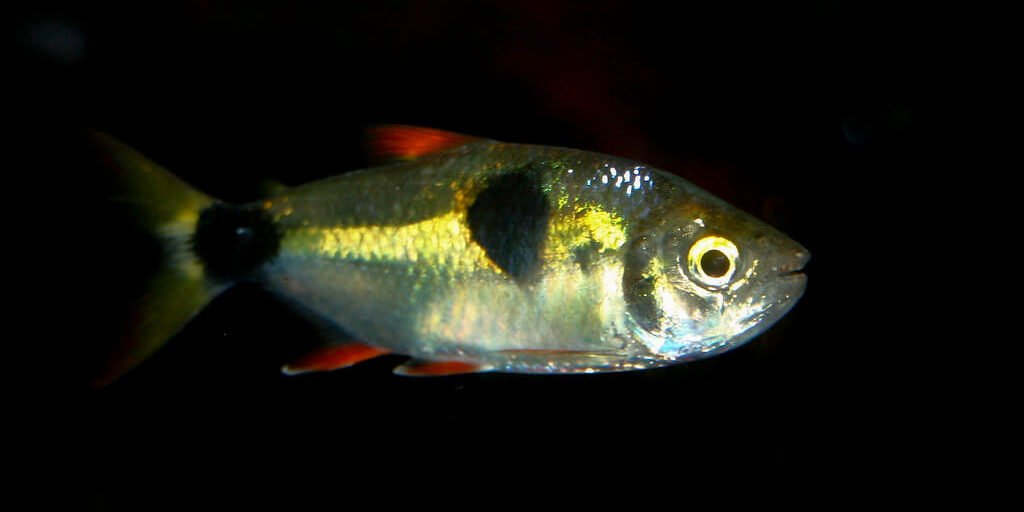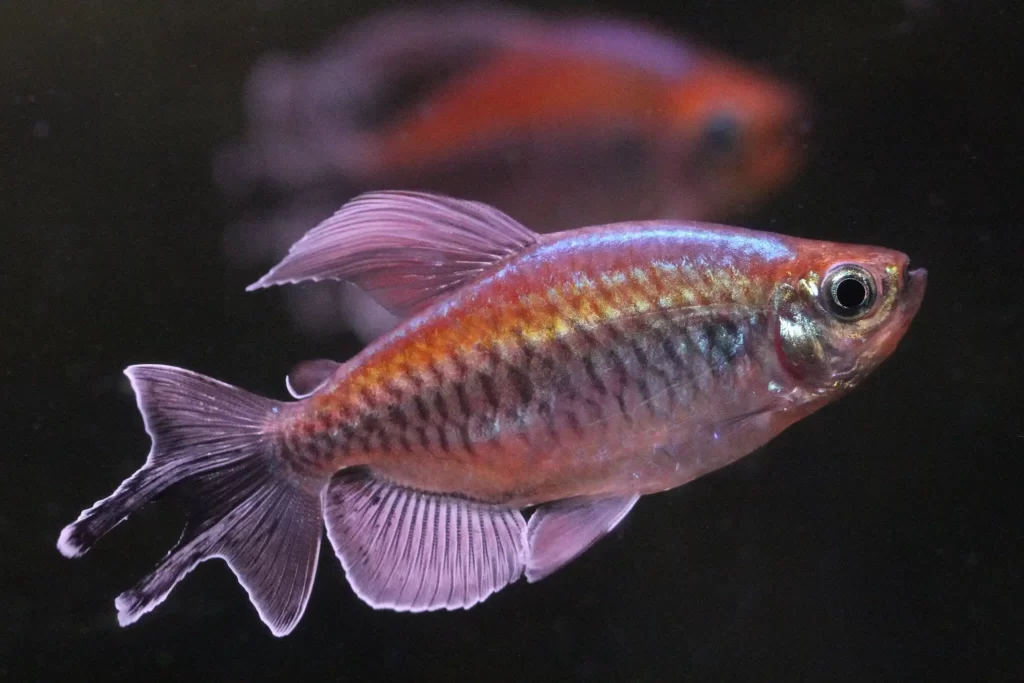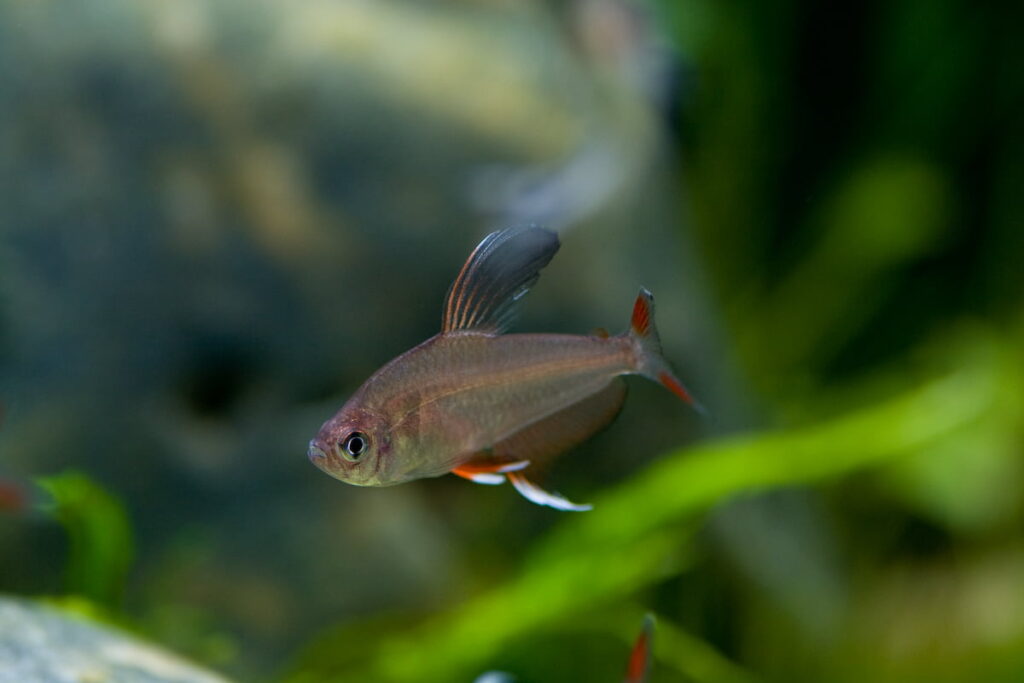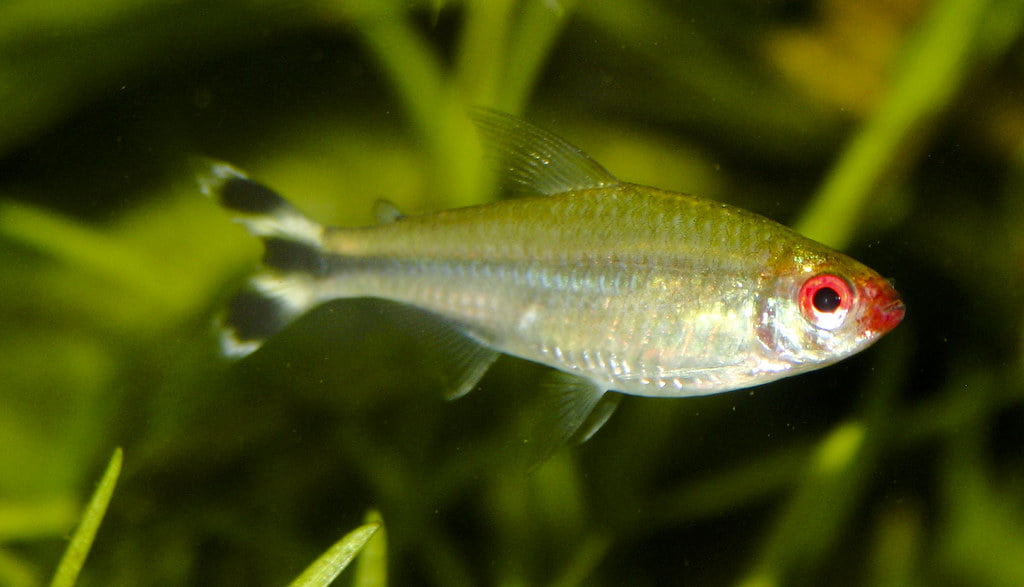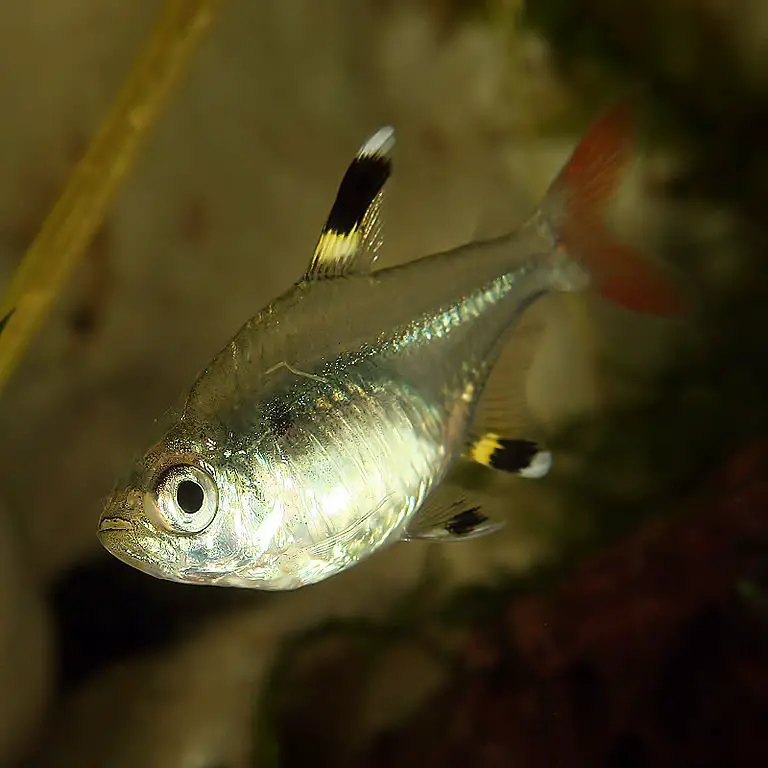Most of us have heard about Piranhas, haven’t we? Well, if you haven’t heard, then Piranhas are a species of fishes with razor-sharp teeth and have a reputation for their ferocity. The movie series Piranha has made us believe that each of them has a taste of blood, which is not entirely accurate; some are vegetarians. Let me introduce Bucktooth tetra, which has an altogether different appearance than Piranhas; however, these fish are more aggressive than a Piranha. The old saying “Never judge a book by its cover” comes true in this case for Bucktooth Tetras.
Despite their “Tetra-like” appearances, the Bucktooth Tetras don’t associate with the nature of a tetra. These natives of Amazon Basin and Guyana are a challenging species of fish for home aquariums. Even though they are small as other regular tetras, their lousy behavior separates them from the regular ones. Although they are an exciting addition to the aquarium, they require intensive care and attention, which we will be discussing in this article.
All About Bucktooth Tetra: A Short Description
Isn’t it curious? A kind of a tetra that does not show similar traits with other tetras. Just like me, I hope that you are also curious about Bucktooth Tetras. Let us look at the tetra’s habitat, appearance, and many more features in the sections below.
Origin, Habitat, and Distribution
Bucktooth Tetra, also known as Exodon paradoxus, was first described in 1845. But it wasn’t until 1932 that the import and distribution of these species by the aquarium trade began. It originated from South America and Tocantins River Basins and is native to the Amazon Basin and Guyana.
The distribution of Bucktooth tetras is over a vast region of Rio Branco in Guyana, Tocantins Rivers in Brazil, and Amazon Basin. They are rare in fish stores making these tetras “Premium Pet Fish” commercially produced worldwide.
Appearance
A Bucktooth Tetra has a beautiful physical feature with a bright metallic-silver semi-transparent body accompanied by fins with hints of red shade. They have an elongated body with yellow spots around two black splotches, one before the tail and another below the dorsal fin. They don’t show signs of actual teeth, somewhat just serrated lips with extremely powerful jaws for its size. The baby Bucktooth isn’t huge, just about to inches, and can grow up to 6 inches.
Price
One Bucktooth Tetra can range from $5.99-$7.99, depending on the size chosen.
Size
The sizes vary as small (1-1.75 inches), medium (1.75-2.5 inches) or large (2.5-3.5 inches). Since it is not a community fish, it is best to keep them in groups of the same species. The general recommendation is to keep a bucktooth in schools of eight to ten or more to prevent them from savaging each other.
Lifespan
Bucktooth Tetra has a comparatively longer life span. This active but unsocial species can live up to 10 years with proper food and water temperature.
Sexual Difference
In Bucktooth Tetra, it is difficult to differentiate between male and female, but male tetras are more active than female tetras. But one of the significant sexual dimorphisms is those mature males are slimmer than females. Another characteristic of a male is that they have slightly elongated dorsal and anal fin rays.
Interesting Fact:
The name “Bucktooth” is a misnomer to Bucktooth Tetra, as they aren’t buck-toothed at all. Moreover, when maintained under optimum water quality and good lighting, the metallic sheen of the body often reflects blue and purple iridescence.
Social Behavior and Tankmates
Unlike most tetras, Bucktooth Tetra is a useless community fish as of their aggressive nature. These species are relatively small fish who fiercely defend their territory, forming schools of eight or more individuals. They only adapt with other fishes of the same species, and they don’t just merely derange from other species; they happen to strip them of fins and scales too. These tetras are not predators in a technical sense but are hungry and crazy for flesh. They feed on the scales of fishes of other species, especially that of silvery fishes. They tend to scare off smaller fishes of their own species, ramming their prey directly.
Another trait of these scale-feeding antics is left or right-handedness. The head of this species seems tilted permanently to either the left or right side. Left-handed Bucktooth attacks the right flank of other fishes, snapping at the scales before glancing away to the tail.
I recommend you keep these fishes away from other species unless the size of the tank is large. These vicious attackers can be okay to live with scale-less catfish species.
Difficulty level
Bucktooth tetras are easy to be set up in a tank, provided the tank is big enough for the school. These species are eye-candy to the keepers who prefer ravenous, flesh-crazed yet innocent-looking fishes.
These tetras are bred locally, for commercial purposes, so setting up the water temperature in tanks is not extremely difficult. Additionally, hygiene and cleanliness should be a top priority for their well-being.
Caring for Bucktooth Tetras: Detailed facts and tips
Maintaining temperature and diet is necessary but not sufficient for the welfare and long-life of a Bucktooth Tetra. They require other additional factors that contribute to the fish’s future.
Caring for your pet fish is very important. It is like caring for your dogs and cats. Just as you form a special bond with other kinds of pets, your fish should also feel the same way. Especially because an aquarium is not their natural home. We need to emphasize more on their well-being as it is our responsibility.
Tank
Setting up the tank of appropriate size is the most crucial part of adopting the Bucktooth tetra. You need to be very attentive towards the size of the tank for your new addition. It is suggested to house the fishes in at least a 20 to 30-gallon aquarium when they are small. But for the shoal of them, it is better to use a 40-gallon to a 60-gallon aquarium with their growing sizes. If the size of the aquarium is not proportional to the number of Tetras in school, you are likely to end up with a lesser amount of survivors.
Setting up a tetra tank for the first time? Check out the details on how to set up the tetra fish aquarium.
Lightning
Bucktooth Tetras spend most of their time out in the open, but take occasional breaks in their hiding places. You can use LED light fixtures of 6500k, but be careful not to use glass under the lights. Proper lighting is also required for the growth of the plants kept inside the aquarium. Under optimum lighting, the metallic sheen of the body often reflects blue and purple iridescence.
Decoration and Substrate
A densely planted Bucktooth tank is best. Other decors like pieces of driftwood, rocks, slate, pots, or artificial caves, can be added to enhance the appearance of the tank, as well as create a more natural habitat for them. Live plants filter and provide oxygen to the water and enjoyed by the Tetras. These additions can be used by the Tetras occasionally as their hiding places.
The suggested plants for the aquarium include broad-leaved species such as Amazon swords and Java fern, grass-like plants such as Vallisneria species, and some floating plants.
These species show their colors best when maintained with a dark substrate and live plants accompanied by a colored background.
Diet
Since we know Buckteeth are aggressive and are predators for scales, they also happen to be a greedy feeder but not a picky eater.
You can feed your fishes with live food like small insects or fish scales, dried foods like some good pellet or flake food, or dead food like chopped prawn, mussels, bloodworms, lancetfish, earthworms, brine or mysid shrimp, or fish fillets. Balancing all of these foods in small quantities several times a day can help you maintain their nutrition. This can also help you in assuring that all the fishes receive enough food and a quiet tank.
Does Bucktooth tetra’s diet differ from other tetra’s diet? Learn more in our article tetra fish diet.
Water Parameters Maintenance
Water parameters are the physical and chemical composition of the water in your tank. Without the proper water parameters, your tank is not suitable for the fish to inhabit. Therefore, the parameters are essential, and you should maintain it correctly for every fish.
Temperature
Bucktooth Tetras are best kept at a temperature of 73°F – 82°F (22.78°C – 27.78°C). At colder places, heaters are definitely recommended.
pH level
Slightly acidic water with a pH level of 5.5-7.5 should be maintained for this fish. It’s suggested to use a water testing kit for better results in health conditions.
Hardness
Though Bucktooth is tolerant of a wide range of water conditions, it prefers soft water, between 0-20°H.
Filtration
Since the species are pets in school, they are in large groups and need to be maintained regularly and efficiently. So, you should be very cautious while choosing your filter. Make sure that it is a high-quality filter like a Penguin 350B Filter, for the bio-dump amount is also high in the large group.
Lava rocks can also be added in the tank to maintain the ideal range of the nitrates.
Know about proper filtration for the tetra fish tank.
Diseases
Bucktooth Tetras are prone to various infectious diseases if you do not take care of them properly. The water in the tank needs frequent replacement with the proper temperature and filtration for keeping the water hygienic. Some of the diseases include fungal infection, cloud eye infection, tuberculosis, hexamita, tapeworms, and many more. You can see most of these diseases transmitted to a healthy fish from an already infected fish, or through poor water quality. The other affecting factor to their health is bullying. Aa bullied fish are more prone to catching some bacterial infections.
It is better to separate the fish from its school and put it in another tank if you notice any behavioral and physical changes. Until you are able to diagnose the disease and treat it. This can help in preventing disorders from other fishes in the tank. It is very crucial to provide timely treatment to the infected fish for their survival. You wouldn’t want to lose your precious Tetra over a minor disease that can be cured with appropriate treatment and proper attention.
Know more about tetra fish diseases.
How to breed Bucktooth Tetras?
Bucktooth Tetra is commercially produced for its sales and distribution locally. If you want to breed your Tetra, then you should consider some essential characteristics of these species, since not many people produce them. Do not put only a pair in the tank, as it can result in more fighting than mating.
As it is challenging to distinguish males and females, you should keep them in their community tank itself as the chance of a female and a male staying together is big.
But if you choose to spawn pair separately, then the tank size of 24″ x 12″ x 12″ should be sufficient. Select the pair and transfer them to the spawning tank.
To speed up the spawning process and give the couple a breeding water parameter, slightly increase the water temperature and perform about 50% water change.
Since the parent will eat their own eggs, they should be removed from the tank as soon as you notice the eggs.
For a successful breeding process, the tank conditions are as follows:
- 24″ x 12″ x 12″ sized tank
- Clumps of fine-leaved plants or mesh or special breeding mops made of nylon yarn for the female to lay eggs on
- Soft and slightly acidic water of pH 6-6.5, gH 1-5
- A slight increase in water temperature than in the community tank
The eggs take 2-3 days to hatch. After hatching, the fry can be fed small live foods such as newly hatched brine shrimp. Cannibalism will probably be rife, so keep a close eye on the young as they grow. Ready other tanks to move the fishes according to their size, to prevent smaller ones being attacked by the bigger ones.
Bucktooth Tetra Summary Chart
Let’s take a quick look at the chart and summarize our information on Bucktooth Tetras:
| Care Level | Easy |
| Scientific Name | Exod paradoxus |
| Origin | Rio Branco in Guyana, Tocantins Rivers in Brazil and Amazon Basin. |
| Behavior | Non-community and aggressive |
| Aggressiveness | Towards scaled or silvery fishes |
| Size | Approximately 3.5 inches (8.9 cm) |
| pH | 5.5-7.5 |
| Temperature | 73°F – 82°F (22.78°C – 27.78°C). |
| Water hardness | 0-20°H. |
| Lifespan | 8-10 years |
| Diet | Live, dead or dried food |
| Minimum aquarium size | 40 gallons |
Conclusion
Bucktooth tetra is a hardy, unique, and ultra-aggressive species with specific challenges that must be met before it can be successfully maintained in an aquarium. It is quite challenging to find the tank mates for these species and even adjusting with their own species. They tend to bully smaller fishes of their own species and are vicious towards all scaled-fishes or any fish with silvery texture.
As much as their nature is predatory, they are quite an eye-candy when petting a school of ten or more. I would recommend you to try to pet this fish if you prefer an active school with a beautiful texture.
Image Reference: https://live.staticflickr.com/3281/3067059860_3beb948b55_b.jpg
